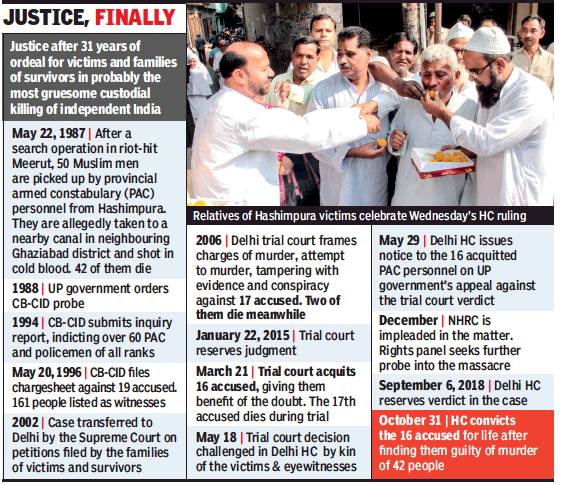Hashimpura massacre, 1987
This is a collection of articles archived for the excellence of their content. |
The survivor’s evidence

From: Sandeep Rai, Shot and left for dead, man survived to recount horror, November 1, 2018: The Times of India
Hashimpura Massacre Witness Who Fought 31 Years For Justice
Babudin Ansari, 48 years old, has been waiting for an answer for 31 years. On Wednesday, when the Delhi high court sentenced 16 Uttar Pradesh Provincial Armed Constabulary (PAC) personnel to life imprisonment for the Hashimpura massacre of May 22, 1987, the survivor who fought for justice for all his adult life got his answer.
“My purpose was to let the world know what had happened that Friday night during Ramzan. I was waiting to know if I had done this task. Today I got my answer,” Ansari said. He was 17 years old when PAC men bundled him into a truck along with dozens of Muslim men from Hashimpura locality here and took them to the bank of a canal in Moradnagar.
“At the canal, the PAC men dragged out one of us and shot him. Panic set in among us, and suddenly the policemen began firing at us while we were still inside the truck. I was hit in the waist. Then the policemen entered the truck and shot me in the chest. They threw the bodies and me, thinking I was dead, into the canal,” Ansari said. He clung to a branch near the bank, barely alive. By the time the shooting ended, 42 men were dead.
Hours later, Ghaziabad police found him and five other survivors, after which then senior superintendent of police VN Rai filed an FIR against the PAC men. Ansari was the only witness who could corroborate the entire sequence of events. He has lost count of the number of times he went to Delhi to appear in the trial. “Probably 400 times in these three decades. I never got any compensation because it was given to the relatives of those who were killed. Every visit to court would cost me a day’s wage in addition to the travelling expenses. But I had to bear witness,” said Ansari.
Relatives of the dead victims welcomed the verdict, but said their grief was still intense. Zulfikar Nasir, one of the five complainants in the case, said, “After the case was filed, we were threatened, to withdraw the case. Justice was delayed, but at least the nation knows that we were wronged.”